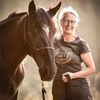Ñandús
Rhea americana
Profile
Size: 127 - 140 cm head height
Weight: 20 - 25 kg
Diet:
Nandus are omnivores,
but prefer plants, leaves, grasses, fruits...
Insects and small vertebrates
A nandu eats about 1.5 kg of plant food per day
Habitat: Wet savannahs and grasslands of Central South America
Enemies: Predators; eagles, foxes, pumas ...
The nandu is a large, flightless ratite.
It owes its name to the mating call of the cock, which runs around with ruffled plumage during the mating season, swinging its neck back and forth to win the favor of the hens. In doing so, it emits a deep, melodious call that sounds like nan-du.
Nandus do not have conspicuous decorative feathers and there is a reason for this: the cock does the brooding. He builds a nest hollow in the ground and covers it with branches and grass and lets several hens lay eggs in his nest. After 2 days, after the first hens have laid their eggs, the nandu cock starts incubating. Up to 30 eggs from 4 - 5 hens can be found in one nest.
The inconspicuous plumage camouflages and protects the expectant father. Enemies such as jaguars and pumas overlook him in the tall grass.
Nandus cannot run as fast as African ostriches, but they can reach impressive speeds of up to 60 km/h. They are also good swimmers and can easily cross a river.
In Germany, there has been a steadily growing nandu population in Mecklenburg-Vorpommern since the early 2000s. Initially, only 7 animals escaped from a nandu farm, but the population has now grown to over 550 nandus.
Whether the nandu should be allowed to stay is the subject of controversial debate between politicians, farmers and conservationists.
In Germany, the bird is strictly protected and may not be hunted, with the exception of Mecklenburg-Western Pomerania. There it has been subject to hunting law since 2020 and may
be hunted. Since then, the population has been declining. In 2022, only 144 birds were counted in the autumn census in Mecklenburg-Western Pomerania.
Ñandús
Rhea americana
Steckbrief
Größe: 127 - 140 cm Kopfhöhe
Gewicht: 20 - 25 kg
Ernährung:
Nandus sind Allesfresser,
bevorzugen aber Pflanzen, Blätter, Gräser, Früchte...
Insekten und kleine Wirbeltiere
Ein Nandu frisst etwa 1,5 kg pflanzliche Nahrung pro Tag
Lebensraum: Feuchtsavannen und Grasland in Zentral-Südamerika
Feinde: Raubtiere; Adler, Füchse, Pumas ...
Der Nandu ist ein großer, flugunfähiger Laufvogel.
Seinen Namen verdankt er dem Paarungsruf des Hahns, der während der Paarungszeit mit gesträubtem Gefieder herumläuft und seinen Hals hin und her schwingt, um die Gunst der Hennen zu gewinnen. Dabei stößt er einen tiefen, melodiösen Ruf aus, der wie nan-du klingt.
Nandus haben keine auffälligen Schmuckfedern, und das hat einen Grund: Der Hahn brütet. Er baut eine Nestmulde in den Boden und deckt sie mit Zweigen und Gras ab und lässt mehrere Hennen in sein Nest Eier legen. Nach 2 Tagen, nachdem die ersten Hennen ihre Eier gelegt haben, beginnt der Nandu-Hahn mit dem Ausbrüten. Bis zu 30 Eier von 4 - 5 Hennen befinden sich in einem Nest.
Das unauffällige Federkleid tarnt und schützt den werdenden Vater. Feinde wie Jaguare und Pumas übersehen ihn im hohen Gras.
Nandus können nicht so schnell rennen wie afrikanische Strauße, aber sie können beeindruckende Geschwindigkeiten von bis zu 60 km/h erreichen. Sie sind auch gute Schwimmer und können problemlos einen Fluss überqueren.
In Deutschland gibt es seit Anfang der 2000er Jahre eine stetig wachsende Nandu-Population in Mecklenburg-Vorpommern. Waren es anfangs nur 7 Tiere, die aus einer Nandu-Farm entkamen, so ist die Population inzwischen auf über 550 Nandus angewachsen.
Ob der Nandu bleiben darf, wird zwischen Politikern, Landwirten und Naturschützern kontrovers diskutiert.
In Deutschland ist der Vogel streng geschützt und darf nicht bejagt werden, mit Ausnahme von Mecklenburg-Vorpommern. Dort unterliegt er seit 2020 dem Jagdrecht und darf
gejagt werden. Seitdem ist der Bestand rückläufig. Im Jahr 2022 wurden bei der Herbstzählung in Mecklenburg-Vorpommern nur noch 144 Vögel gezählt.
Du kannst dich freuen: Dein Foto Ñandús wird am 12.09.2024 von 12:00 bis 14:00 Uhr auf unserer Startseite https://www.fotocommunity.com präsentiert.























Blula 11/09/2024 14:54
Was für ein hübscher Kerl !!!Ein ganz starkes Portrait ist das, was Du hier zeigst. Der Schnitt ist bestens !
LG Ursula
Rainer Switala 11/09/2024 14:48
info und portrait gefallen mirgruß rainer
Wolfgang Weninger 10/09/2024 18:06
sie wären ja so kuschelig, wenn sie nicht immer so schnappen möchten :-)Servus, Wolfgang
Dorothea Weckmann - Piper 10/09/2024 15:46
ein ganz feines Portrait ist Dir, liebe Babs, hier wieder gelungen!!LG Dorothea
Maria Kohler 10/09/2024 14:37
Super gut ist dein Portrait von dem Nandu.LG Maria
agezur 10/09/2024 14:28
Er schaut so verschmitzt , als ob er genau wüsste dass jetzt von ihm ein Porträt gemacht wird!LG Christina
Daniela Boehm 10/09/2024 13:54
Wir hübsch und toll die Frisur… liebe Grüße DaniWolfgang Kaeding 10/09/2024 13:14
Hallo Babs,ein ganz tolles Porträt vom Nandu.
Viele GRüße Wolfgang
Brigitte Schönewald 10/09/2024 10:41
Ein herrliches Portrait mit feinem Bokeh.LG Brigitte
Mary.D. 10/09/2024 8:23
Das ist ein sehr schönes Portrait , was du vom Ñandús gemacht hast!LG Mary
Urs E. 09/09/2024 23:35
Ich denke, wir sind uns noch nie vorher begegnet ;-)LG Urs
P.S. Danke für die vielen Infos!
Marguerite L. 09/09/2024 22:51
Ein Schätzchen,den einzigen Nandu habe ich in den Anden gesehen ...
Nandu
Marguerite L.